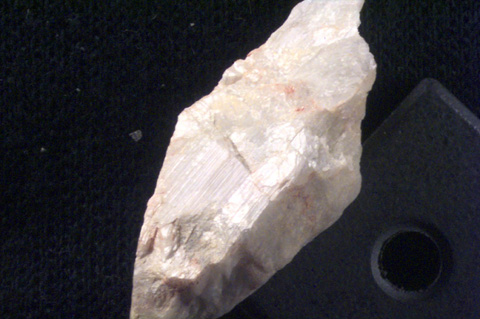igneous rocks
metamorphic rocks
sedimentary rocks
|

A feldspar mineral, typically white to light gray, with two directions of cleavage at 90 degrees. Cleavages are well developed and commonly seen in specimens in rocks. The third direction fractures, however, and has an irregular, broken appearance. The fracture surface is the top surface in this picture, but note the cleavage face on the right side. A common property is striations (fine, very even grooves on the cleavage surface, not present on this specimen.) The surface is typically transluscent, that is, light seems to penetrate below the surface so you can see into the mineral.
Feldspar crystal structure is complex but consists of rings of four tetrahedra (resulting in the 4-sided 90 cleavage), strung into warped chains, held together ionically by metallic cations. The specific cations determine the particular feldspar obtained ( See Link)
In felsic igneous rocks na plagioclase is common. In intermediate igneous rocks plagioclase becomes more calcium rich but the color tends to remain white or light gray.
Another Sample

A feldspar mineral, typically white to light gray, with two directions of cleavage at 90 degrees. Cleavages are well developed and commonly seen in specimens in rocks. The third direction fractures, however, and has an irregular, broken appearance. The top shiny face and lower right surface (in shadow) are the cleavage faces in this picture. The fracture face is the upper right end of the crystal. A common property is striations (fine, very even grooves on the cleavage surface, well developed on this specimen.) The surface is typically transluscent, that is, light seems to penetrate below the surface so you can see into the mineral.
In felsic igneous rocks na plagioclase is common. In intermediate igneous rocks plagioclase becomes more calcium rich but the color tends to remain white or light gray.
|